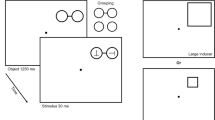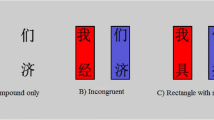Abstract
Different types of objects that are overlapped or adjacent in space usually have close semantic relationships in real-world scenes. Previous studies have found that different types of objects can elicit the object-based effects and have confirmed that these object-based effects, which are just overlapped, cannot be additive. However, it is still unclear whether object-based effects induced by different types of objects can be additive if they have a close semantic relationship. Therefore, the purpose of the current study was to investigate whether and how semantic matching affected the additive effects of object-based attention by adopting the variant of the two-rectangle paradigm and simultaneously/solely presenting lexically defined and geometrically defined objects (Experiment 1) or real objects (Experiment 2). We found that space- and object-based effects were observed for different types of stimuli. The difference in the space-based effects among the geometric only, Chinese words only, and semantically mismatched and semantically matched conditions was not significant. However, the object-based effects were larger for the semantically matched condition than those for semantically mismatched, geometric only and Chinese words only conditions, which were not different from one another. These results suggest that different types of objects can not only steadily induce object-based effects, but also give rise to the additive effects of object-based attention depending on whether they have close semantic relationships.



Similar content being viewed by others
Data Availability
The data and materials for all experiments are available at the Open Science Framework website: https://osf.io/jvbk5/.
References
De Groot, F., Huettig, F., & Olivers, C. N. L. (2016). When meaning matters: The temporal dynamics of semantic influences on visual attention. Journal of Experimental Psychology Human Perception & Performance, 42(2), 180–196. https://doi.org/10.1037/xhp0000102
Duncan, J. (1984). Selective attention and the organization of visual information. Journal of Experimental Psychology: General, 113, 501–517. https://doi.org/10.1037/0096-3445.113.4.501
Egly, R., Driver, J., & Rafal, R. D. (1994). Shifting visual attention between objects and locations: Evidence from normal and parietal lesion subjects. Journal of Experimental Psychology: General, 123, 161–177. https://doi.org/10.1037/0096-3445.123.2.161
Eriksen, C. W., & James, J. D. S. (1986). Visual attention within and around the field of focal attention: A zoom lens model. Attention, Perception, & Psychophysics, 40(4), 225–240. https://doi.org/10.3758/bf03211502
Faul, F., Erdfelder, E., Buchner, A., & Lang, A. G. (2009). Statistical power analyses using G * power 3.1: tests for correlation and regression analyses. Behavior Research Methods, 41(4), 1149–1160. https://doi.org/10.3758/BRM.41.4.1149
Gronau, N. (2020). Vision at a glance: The role of attention in processing object-to-object categorical relations. Attention Perception & Psychophysics, 82(2), 671–688. https://doi.org/10.3758/s13414-019-01940-z
Hayes, T. R., & Henderson, J. M. (2019). Scene semantics involuntarily guide attention during visual search. Psychonomic Bulletin & Review, 26(5), 1683–1689. https://doi.org/10.3758/s13423-019-01642-5
Hein, E., Blaschke, S., & Rolke, B. (2017). The influence of object similarity and orientation on object-based cueing. Attention Perception & Psychophysics, 79(1), 63–77. https://doi.org/10.3758/s13414-016-1229-x
Hoffman, J. E., & Nelson, B. (1981). Spatial selectivity in visual search. Perception & Psychophysics, 30, 283–290. https://doi.org/10.3758/BF03214284
Hu, S., Liu, D., Song, F., Wang, Y., & Zhao, J. (2020). The influence of object similarity on real object-based attention: The disassociation of perceptual and semantic similarity. Acta Psychologica, 205, e103046. https://doi.org/10.1016/j.actpsy.2020.103046
Hu, S., Zhang, T., Wang, Y., Song, F., Zhao, J., & Wang, Y. (2021). The modulation of object-based attentional selection by facial expressions. Quarterly Journal of Experimental Psychology, 74(7), 1244–1256. 174702182199176
Huettig, F., & Altmann, G. T. M. (2005). Word meaning and the control of eye fixation: Semantic competitor effects and the visual world paradigm. Cognition, 96(1), B23–B32. https://doi.org/10.1016/j.cognition.2004.10.003
Huettig, F., Quinlan, P. T., Mcdonald, S. A., & Altmann, G. (2006). Models of high-dimensional semantic space predict language-mediated eye movements in the visual world. Acta Psychologica, 121(1), 65–80. https://doi.org/10.1016/j.actpsy.2005.06.002
Kravitz, D. J., & Behrmann, M. (2011). Space-, object-, and feature-based attention interact to organize visual scenes. Attention Perception & Psychophysics, 73(8), 2434–2447. https://doi.org/10.3758/s13414-011-0201-z
Li, X., & Logan, G. D. (2008). Object-based attention in Chinese readers of Chinese words: Beyond Gestalt principles. Psychonomic Bulletin & Review, 15(5), 945–949. https://doi.org/10.3758/PBR.15.5.945
Liu, D., Wang, Y., & Zhou, X. (2011). Lexical- and perceptual-based object-based effects in the two-rectangle cuing paradigm. Acta Psychologica, 138(3), 397–404. https://doi.org/10.1016/j.actpsy.2011.09.008
Malcolm, G. L., & Shomstein, S. (2015). Object-based attention in real-world scenes. Journal of Experimental Psychology General, 144(2), 257–263. https://doi.org/10.1037/xge0000060
Malcolm, G. L., Rattinger, M., & Shomstein, S. (2016). Intrusive effects of semantic information on visual selective attention. Attention Perception & Psychophysics, 78(7), 2066–2078. https://doi.org/10.3758/s13414-016-1156-x
Meyer, A. S., Belke, E., Telling, A. L., & Humphreys, G. W. (2007). Early activation of object names in visual search. Psychonomic Bulletin & Review, 14(4), 710–716. https://doi.org/10.3758/BF03196826
Moores, E., Latti, L., & Chelazzi, L. (2003). Associative knowledge controls deployment of visual selective attention. Nature Neuroscience., 6, 182–189. https://doi.org/10.1038/nn996
Posner, M. I., Snyder, C. R. R., & Davidson, B. J. (1980). Attention and the detection of signals. Journal of Experimental Psychology. General, 109, 106–174. https://doi.org/10.1037/0096-3445.109.2.160
Richard, A. M., Lee, H., & Vecera, S. P. (2008). Attentional spreading in object-based attention. Journal of Experimental Psychology: Human Perception and Performance, 34(4), 842–853. https://doi.org/10.1037/0096-1523.34.4.842
Scotti, P., Malcolm, G., Peterson, M., & Shomstein, S. (2016). Reality vs. simplicity: the effects of real-world objects on attentional selection. Journal of Vision, 16(12), 700. https://doi.org/10.1167/16.12.700
Shomstein, S., & Behrmann, M. (2008). Object-based attention: Strength of object representation and attentional guidance. Perception & Psychophysics, 70(1), 132–144. https://doi.org/10.3758/PP.70.1.132
Shomstein, S., & Yantis, S. (2004). Configural and contextual prioritization in object-based attention. Psychonomic Bulletin & Review, 11(2), 247–253. https://doi.org/10.3758/BF03196566
Song, F., Zhou, S., Gao, Y., Hu, S., Zhang, T., Kong, F., & Zhao, J. (2021). Are You Looking at Me? Impact of Eye Contact on Object-Based Attention. Journal of Experimental Psychology: Human Perception and Performance., 47(6), 765–773. https://doi.org/10.1037/xhp0000913
Wyble, B., Folk, C., & Potter, M. C. (2013). Contingent attentional capture by conceptually relevant images. Journal of Experimental Psychology: Human Perception & Performance, 39(3), 861–871. https://doi.org/10.1037/a0030517
Yee, E., & Sedivy, J. C. (2006). Eye movements to pictures reveal transient semantic activation during spoken word recognition. Journal of Experimental Psychology: Learning Memory & Cognition, 32(1), 1–14. https://doi.org/10.1037/0278-7393.32.1.1
Yee, E., Overton, E., & Thompson-Schill, S. L. (2009). Looking for meaning: Eye movements are sensitive to overlapping semantic features, not association. Psychonomic Bulletin & Review, 16(5), 869–874. https://doi.org/10.3758/PBR.16.5.869
Zhao, J., Wang, Y., & Liu, D. (2015). Strength of object representation: Its key role in object-based attention for determining the competition result between Gestalt and top-down objects. Attention, Perception, & Psychophysics, 77(7), 2284–2292. https://doi.org/10.3758/s13414-015-0922-5
Zhao, J., Song, F., Zhou, S., Hu, S., & Kong, F. (2020). The impact of monetary stimuli on object-based attention. British Journal of Psychology, 111, 460–472. https://doi.org/10.1111/bjop.12418
Acknowledgements
This study was supported by grant from the Fundamental Research Funds for the Central Universities (GK202003096) and the Young Talent fund of University Association for Science and Technology in Shaanxi, China (20210206) to Jingjing Zhao and the Fundamental Research Funds for the Central Universities (2019TS136) to Saisai Hu.
Funding
This study was supported by grant from the Fundamental Research Funds for the Central Universities (GK202003096) and the Young Talent fund of University Association for Science and Technology in Shaanxi, China (20210206) to Jingjing Zhao and the Fundamental Research Funds for the Central Universities (2019TS136) to Saisai Hu.
Author information
Authors and Affiliations
Contributions
S. Hu, D. Liu and Y. Wang conceived and designed the experiments. Testing and data collection were performed by S. Hu, D. Liu, Y. Gao, L. Xiong and D. Yao. S. Hu and D. Liu performed the data analysis and interpretation under the supervision of Y. Wang and J. Zhao. S. Hu drafted the manuscript, and Y. Wang and J. Zhao provided critical revisions. All authors approved the final version of the manuscript for submission.
Corresponding authors
Ethics declarations
Conflicts of Interest
The authors have no financial or proprietary interests in any material discussed in this article.
Ethical Approval
All procedures performed in studies involving human participants were in accordance with the ethical standards of the institutional and/or national research committee and with the 1964 Helsinki Declaration and its later amendments or comparable ethical standards. This study was approved by the Ethics Committee on Human Experimentation of the School of Psychology of Shaanxi Normal University. Informed consent was obtained from all individual participants included in the study.
Additional information
Publisher's Note
Springer Nature remains neutral with regard to jurisdictional claims in published maps and institutional affiliations.
Rights and permissions
About this article
Cite this article
Hu, S., Liu, D., Gao, Y. et al. The impact of semantic matching on the additive effects of object-based attentional selection. Curr Psychol 42, 17985–17994 (2023). https://doi.org/10.1007/s12144-022-02990-7
Accepted:
Published:
Issue Date:
DOI: https://doi.org/10.1007/s12144-022-02990-7




